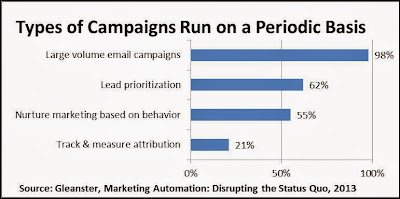I’ve been writing a paper on the stages that marketers go through when deploying their marketing automation systems, the basic point being it’s important not to stop with just one feature. That much is indisputable, but the next question seemed to call for some empirical data: Which features are used most often? Here’s where things got interesting.
Searching through my trove of published reports, I found four recent surveys that asked this question. Of course they differed in the precise categories used and their audiences, but they generally covered the major B2B marketing automation features: email, Web behavior tracking, landing pages, nurture campaigns, lead scoring, analytics, and social media marketing. They differ considerably in their findings.
The table below shows a summary of the results, with values all normalized so the highest ranked answer in each survey equals 100. (I’ve shown the original results at the bottom of this post.)
As you see, the only answer that’s truly consistent is that the most commonly-used feature is email – although even that wasn’t quite true in Holger Schulze’s report. This is exactly what you’d expect; indeed, my paper was inspired by the lament that many companies use marketing automation as nothing more than a glorified email engine.
The remaining rankings are nowhere near as consistent, either with each other or my expectations. I’d guess that landing pages and Web tracking would be relatively common, since they’re basic features that yield clear value and are easy to deploy. Yet both ranked towards the bottom of the list. On the other hand, nurture campaigns are often considered the most complicated and least used feature of marketing automation but ranked closer to the top. (I'll rationalize that one by guessing that people included simple newsletters and drip sequences along with more complicated nurture programs.) Lead scoring, another advanced application, was closer to its expected position near the bottom. Analytics ranked somewhere in the middle but that hides a broad variance between surveys, which suggests it meant different things to different people.
Social media, another very broad category, was only on two lists but did rank at the bottom of both. This also makes sense: it’s a relatively new application for marketing automation and many marketers don’t do it at all or use other tools.
The divergence of rankings leaves the results open to pretty much whatever interpretation you want. Rather than sweating the details, it may be more useful to think of landing pages, Web tracking, nurture campaigns, and lead scoring as a single group of applications that are deployed after email but more-or-less simultaneously with each other. That’s how I do things in my own maturity model, which then adds two more layers: one for inbound marketing including social media and search marketing, and another for marketing management including planning, project management, and revenue attribution. Those don’t appear on my previous table because they’re not consistently included in the surveys, but you will find them in some of the individual surveys below. They ranking towards the bottom in frequency, as you’d expect.
The paper I mentioned goes into the maturity model in more detail. (I'll let you know when it's published). It shows that each level involves new skills and organizational changes, so moving from one to the next takes a lot more than just turning on more system features. This is presumably why so many organizations get stuck at the first or second levels.
Here are details and links for the surveys I’ve summarized above:
Holger Schulze, B2B Lead Generation Marketing Trends, 2013 Survey Results.
More than 800 responses from the B2B Technology Marketing Community on LinkedIn. Note that not everyone is a marketing automation user.
Aberdeen Group, Marketing Lead Management: From the Top of the Funnel to the Top Line, July 2012. More than 160 respondents; the table below shows responses for “industry average” companies. One anomaly worth noting is that while the chart below shows lead nurturing as more common than lead scoring, the order is reversed among best-in-class and laggards.
Gleanster, Marketing Automation: Disrupting the Status Quo, August 2013. Research from 1,396 B2B marketers. The table below shows consolidated results from top performers and others, kindly provided by study author Ian Michiels. The second table shows types of campaigns run by the same group of respondents.
Winsper, 2013 Marketing Automation Study. 132 responders who use a marketing automation system. Figures show “most utilized” features; total utilization is much higher – for example, 94% make some use of email automation.
Wednesday, October 09, 2013
Subscribe to:
Post Comments (Atom)









2 comments:
Interesting findings. I think what this data really tells us is that the marketing automation industry - which is 10 years old - is ripe for disruption. The dominant players are too hard to use, require dedicated administrators and/or an investment in expensive consultants, and simply don't delivery the benefits promised. Every day we talk with folks who are fed up with their existing marketing automation solution and aren't going to take any more. As an industry, we can and must do better - by building products that feel like consumer products and make building landing pages and even the most complex automated campaign trivially easy.
Hi Marcia. I really wonder whether the problem is that the solutions are hard to use, or that companies don't make all the other changes in processes, content creation, program design, etc., that they need to be effective. Easier is always better, I guess, but even if you could snap your fingers (or hire an agency to do the work), the other requirements would remain.
Post a Comment